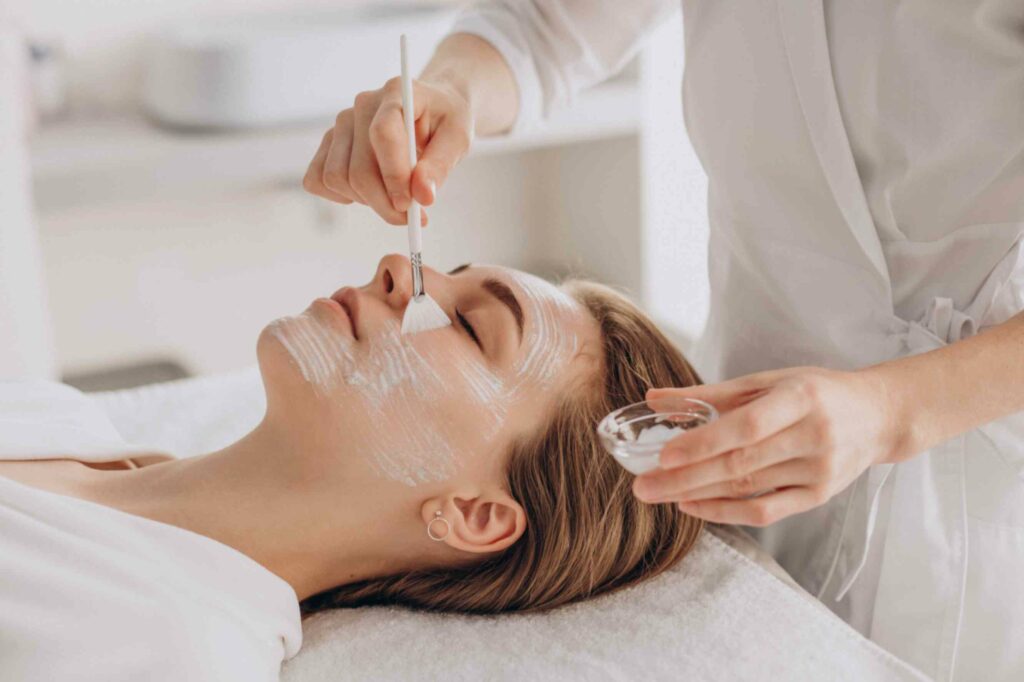Thanks to AI devices that can scan your skin with the same accuracy as dermatologists, professionals can now perform professional skin analyses. These smart systems use high-resolution cameras and machine learning algorithms to detect fine lines and wrinkles, as well as pigmentation and pore size. These systems map the entire skin to reveal invisible problems. Handheld scanners are one of the latest innovations. They can measure things like collagen density, skin elasticity, and even moisture levels, giving you scientific information to help you choose the best skincare routine. Some high-tech models can connect to smartphone apps to track progress over weeks and months, while others use augmented reality to show you how the treatment is working. Thanks to this new diagnostic method, you can now gain insight into your skin’s needs just like a real skincare expert.
A New Approach to LED Light Therapy
The latest generation of at-home LED devices delivers clinical-grade light therapy with smart adjustment options that change based on your skin’s daily condition. Modern systems don’t just use one color; they combine different wavelengths—blue for acne, red for collagen stimulation, and amber for inflammation—in programmable sequences tailored to your specific needs. Some devices are equipped with sensors that monitor your skin before each treatment and automatically adjust the length and intensity of the light for optimal results. The smartest models even work with smartphone apps to determine which treatment is needed based on factors like smoke levels and UV exposure. These changes have made professional light therapy more accessible and effective than ever before. Research shows that just a few weeks of regular use can make a big difference in your skin’s texture and tone.
Rejuvenate Your Skin with Micro and Nano Currents
Once reserved for facial toning, microcurrent devices now feature built-in nanocurrent technology that works at a cellular level to regenerate the skin. These high-tech systems send precise electrical currents that mimic the body’s own bioelectrical signals. This increases ATP production, which energizes cells and stimulates collagen synthesis. The latest models are equipped with smart sensors that measure skin conductivity in real time and automatically adjust the intensity for optimal results without causing pain. Some people use microcurrent in combination with red light therapy and therapeutic vibrations for even better anti-aging results. Clinical studies have shown that regular use of these devices can reduce wrinkle depth by up to 30% and firm up the skin by up to 25%. They can be an alternative to invasive cosmetic surgery.
Cryotherapy and Thermal Technology for Younger-looking Skin
New cryotherapy devices bring the firming effects of extreme cold treatments into your daily skincare routine. Smart heat tools use controlled heat to make products work better. The latest systems switch between heating and cooling to improve circulation and lymphatic drainage. This will immediately lift the skin and stimulate collagen production over time. Some devices are equipped with temperature monitors that keep the device within the optimal therapeutic range, preventing damage to the skin and achieving the best results. Because these techniques are so effective at reducing puffiness, tightening pores, and giving the skin a healthy glow, many people see changes in their skin after just one treatment.
Ultrasound and Plasma Skin Remodeling
Modern ultrasound devices can now professionally exfoliate and deliver products without irritating the skin. They work by using high-frequency movements to remove dead skin cells and push active ingredients deep into the skin. At the same time, new plasma technology creates controlled micro-damage, which kick-starts the skin’s natural healing process and improves skin texture. The latest models feature smart timers and variable intensity levels to ensure the treatment is safe and effective. These techniques are as effective as medical treatments, reducing acne scars, fine lines, and uneven skin tone without the need for downtime or harsh chemicals.
Biometric Wearables for Skin Monitoring
Wearable devices that monitor skin health all day long could be the next big breakthrough in beauty technology. These tiny monitors track your skin’s moisture levels, UV exposure, pollution exposure, and even stress-induced skin changes, sending real-time alerts to your phone. Some of the more advanced models look at sweat composition to detect nutritional deficiencies that compromise skin quality, while others look at sleep patterns to understand how they affect skin regeneration. This constant stream of biometric data allows for truly personalized skincare that adapts to your body’s changing needs and the challenges it faces in your environment.
Conclusion
The revolution in beauty technology is making professional skincare accessible to everyone, as smart devices make it possible to assess, treat, and monitor skin health with unprecedented precision. These innovations combine sound science with user-friendly designs to offer safe and effective alternatives to invasive procedures. As these technologies continue to improve, it’s becoming increasingly difficult to differentiate between home care and professional treatment. This gives people more freedom to achieve and maintain radiant, youthful skin on their own terms. Now more than ever, we need better, more personalized, and more effective skin care.
FAQs
1. How often should I use these high-tech skin care products?
Most gadgets are best used two to three times a week for best results, but some, like wearable technology, can be used all the time.
2. Are these products safe for all skin types?
While generally safe, people with sensitive skin or certain medical conditions should read product instructions first and consult a dermatologist if necessary.
3. How long will it take to see results?
Most people see improvements within two to four weeks. Optimal results are achieved after eight to 12 weeks of consistent use.
4. Can these gadgets replace professional care?
They are very useful for maintenance and improvements, but they cannot replace professional medical treatment for serious problems.
5. How much does it cost compared to a spa treatment?
Although the initial cost can be Rs 200-500, these devices usually pay for themselves within 6-12 months, while professional services take longer.

Pini Sharma is a health and beauty writer who wants to change the way people think about beauty by making it more open and innovative. Pini writes about the latest beauty technology and shares expert makeup tips at savepini.com. She has also spoken out about body positivity in a new and powerful way. Her goal is for everyone to feel good about themselves and express themselves freely.

